LINCOLN NAUTILUS 2021 Service Manual
Manufacturer: LINCOLN, Model Year: 2021, Model line: NAUTILUS, Model: LINCOLN NAUTILUS 2021Pages: 579, PDF Size: 6.9 MB
Page 41 of 579
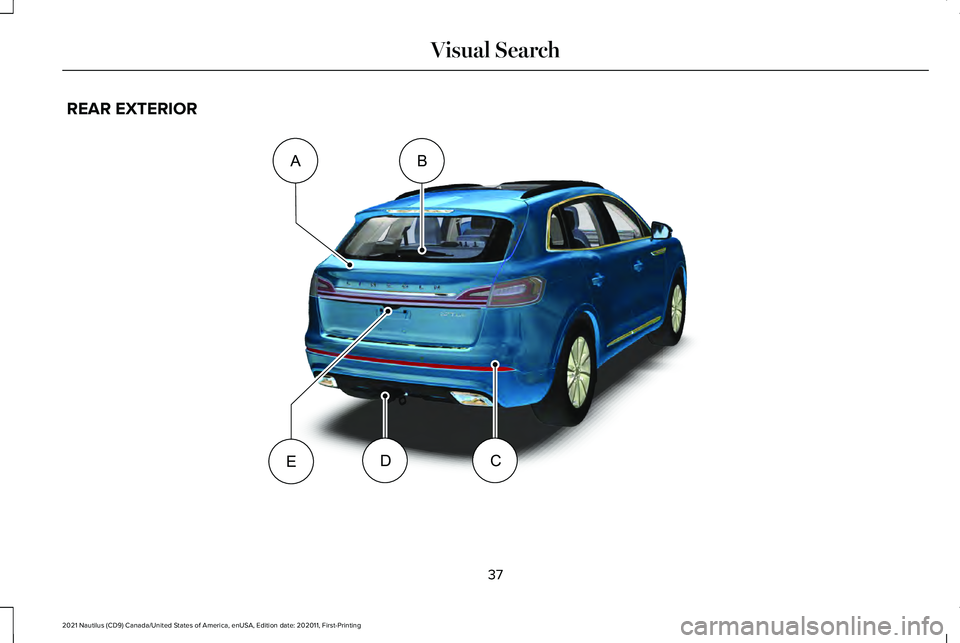
REAR EXTERIOR
37
2021 Nautilus (CD9) Canada/United States of America, enUSA, Edition date: 202011, First-Printing Visual SearchAB
CDEE332372
Page 42 of 579
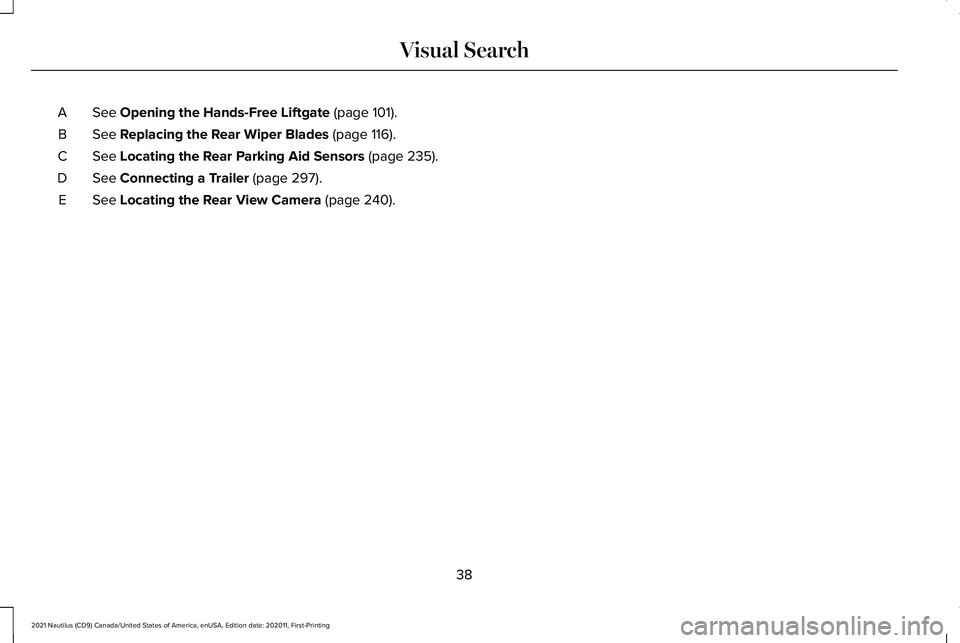
See Opening the Hands-Free Liftgate (page 101).
A
See
Replacing the Rear Wiper Blades (page 116).
B
See
Locating the Rear Parking Aid Sensors (page 235).
C
See
Connecting a Trailer (page 297).
D
See
Locating the Rear View Camera (page 240).
E
38
2021 Nautilus (CD9) Canada/United States of America, enUSA, Edition date: 202011, First-Printing Visual Search
Page 43 of 579
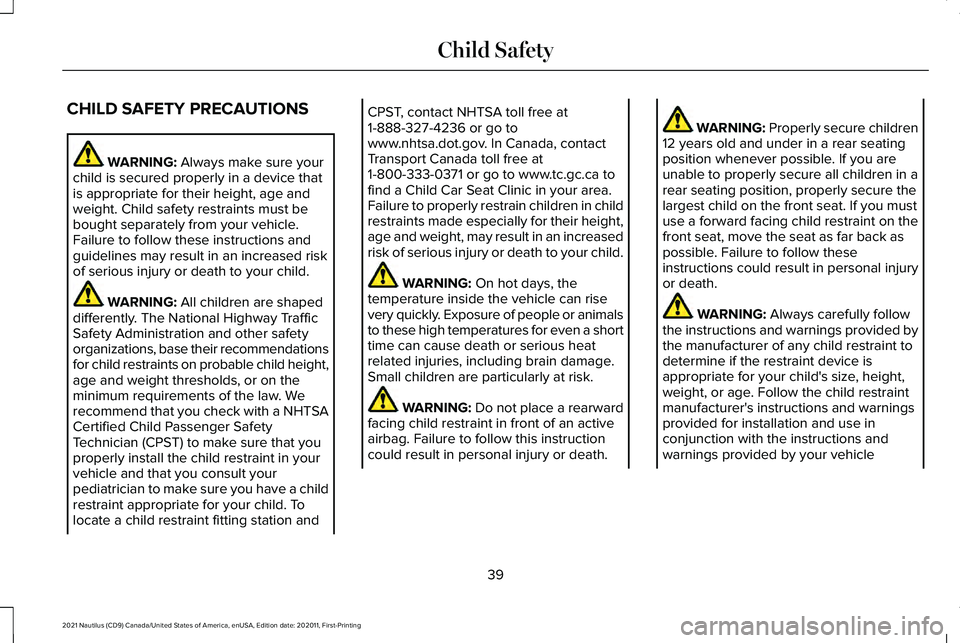
CHILD SAFETY PRECAUTIONS
WARNING: Always make sure your
child is secured properly in a device that
is appropriate for their height, age and
weight. Child safety restraints must be
bought separately from your vehicle.
Failure to follow these instructions and
guidelines may result in an increased risk
of serious injury or death to your child. WARNING:
All children are shaped
differently. The National Highway Traffic
Safety Administration and other safety
organizations, base their recommendations
for child restraints on probable child height,
age and weight thresholds, or on the
minimum requirements of the law. We
recommend that you check with a NHTSA
Certified Child Passenger Safety
Technician (CPST) to make sure that you
properly install the child restraint in your
vehicle and that you consult your
pediatrician to make sure you have a child
restraint appropriate for your child. To
locate a child restraint fitting station and CPST, contact NHTSA toll free at
1-888-327-4236 or go to
www.nhtsa.dot.gov. In Canada, contact
Transport Canada toll free at
1-800-333-0371 or go to www.tc.gc.ca to
find a Child Car Seat Clinic in your area.
Failure to properly restrain children in child
restraints made especially for their height,
age and weight, may result in an increased
risk of serious injury or death to your child.
WARNING:
On hot days, the
temperature inside the vehicle can rise
very quickly. Exposure of people or animals
to these high temperatures for even a short
time can cause death or serious heat
related injuries, including brain damage.
Small children are particularly at risk. WARNING:
Do not place a rearward
facing child restraint in front of an active
airbag. Failure to follow this instruction
could result in personal injury or death. WARNING:
Properly secure children
12 years old and under in a rear seating
position whenever possible. If you are
unable to properly secure all children in a
rear seating position, properly secure the
largest child on the front seat. If you must
use a forward facing child restraint on the
front seat, move the seat as far back as
possible. Failure to follow these
instructions could result in personal injury
or death. WARNING:
Always carefully follow
the instructions and warnings provided by
the manufacturer of any child restraint to
determine if the restraint device is
appropriate for your child's size, height,
weight, or age. Follow the child restraint
manufacturer's instructions and warnings
provided for installation and use in
conjunction with the instructions and
warnings provided by your vehicle
39
2021 Nautilus (CD9) Canada/United States of America, enUSA, Edition date: 202011, First-Printing Child Safety
Page 44 of 579
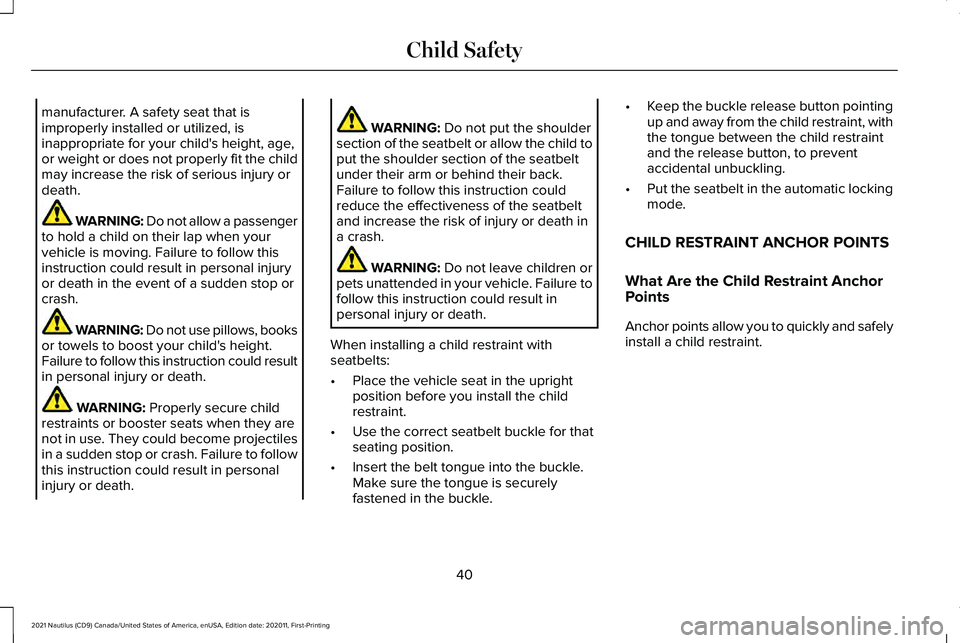
manufacturer. A safety seat that is
improperly installed or utilized, is
inappropriate for your child's height, age,
or weight or does not properly fit the child
may increase the risk of serious injury or
death.
WARNING: Do not allow a passenger
to hold a child on their lap when your
vehicle is moving. Failure to follow this
instruction could result in personal injury
or death in the event of a sudden stop or
crash. WARNING: Do not use pillows, books
or towels to boost your child's height.
Failure to follow this instruction could result
in personal injury or death. WARNING: Properly secure child
restraints or booster seats when they are
not in use. They could become projectiles
in a sudden stop or crash. Failure to follow
this instruction could result in personal
injury or death. WARNING:
Do not put the shoulder
section of the seatbelt or allow the child to
put the shoulder section of the seatbelt
under their arm or behind their back.
Failure to follow this instruction could
reduce the effectiveness of the seatbelt
and increase the risk of injury or death in
a crash. WARNING:
Do not leave children or
pets unattended in your vehicle. Failure to
follow this instruction could result in
personal injury or death.
When installing a child restraint with
seatbelts:
• Place the vehicle seat in the upright
position before you install the child
restraint.
• Use the correct seatbelt buckle for that
seating position.
• Insert the belt tongue into the buckle.
Make sure the tongue is securely
fastened in the buckle. •
Keep the buckle release button pointing
up and away from the child restraint, with
the tongue between the child restraint
and the release button, to prevent
accidental unbuckling.
• Put the seatbelt in the automatic locking
mode.
CHILD RESTRAINT ANCHOR POINTS
What Are the Child Restraint Anchor
Points
Anchor points allow you to quickly and safely
install a child restraint.
40
2021 Nautilus (CD9) Canada/United States of America, enUSA, Edition date: 202011, First-Printing Child Safety
Page 45 of 579
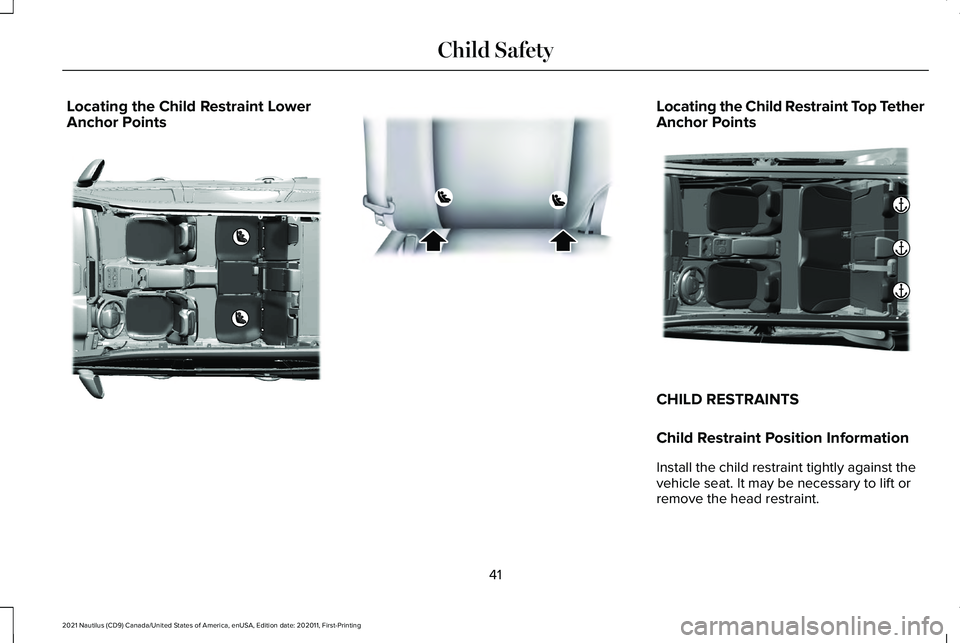
Locating the Child Restraint Lower
Anchor Points Locating the Child Restraint Top Tether
Anchor Points
CHILD RESTRAINTS
Child Restraint Position Information
Install the child restraint tightly against the
vehicle seat. It may be necessary to lift or
remove the head restraint.
41
2021 Nautilus (CD9) Canada/United States of America, enUSA, Edition date: 202011, First-Printing Child SafetyE318267 E196697 E316055
Page 46 of 579
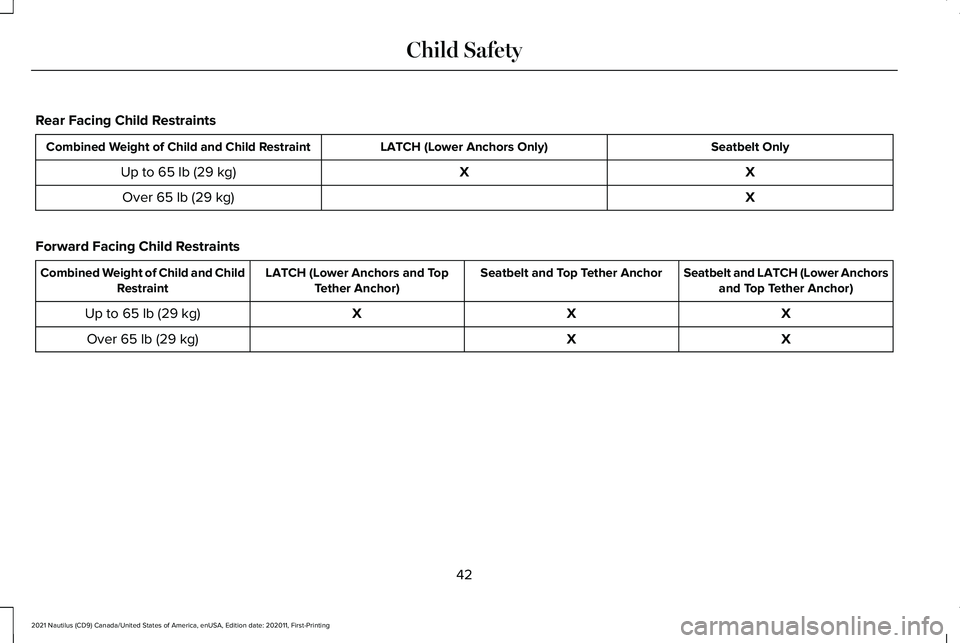
Rear Facing Child Restraints
Seatbelt Only
LATCH (Lower Anchors Only)
Combined Weight of Child and Child Restraint
X
X
Up to 65 lb (29 kg)
X
Over
65 lb (29 kg)
Forward Facing Child Restraints Seatbelt and LATCH (Lower Anchors
and Top Tether Anchor)
Seatbelt and Top Tether Anchor
LATCH (Lower Anchors and Top
Tether Anchor)
Combined Weight of Child and Child
Restraint
X
X
X
Up to
65 lb (29 kg)
X
X
Over
65 lb (29 kg)
42
2021 Nautilus (CD9) Canada/United States of America, enUSA, Edition date: 202011, First-Printing Child Safety
Page 47 of 579
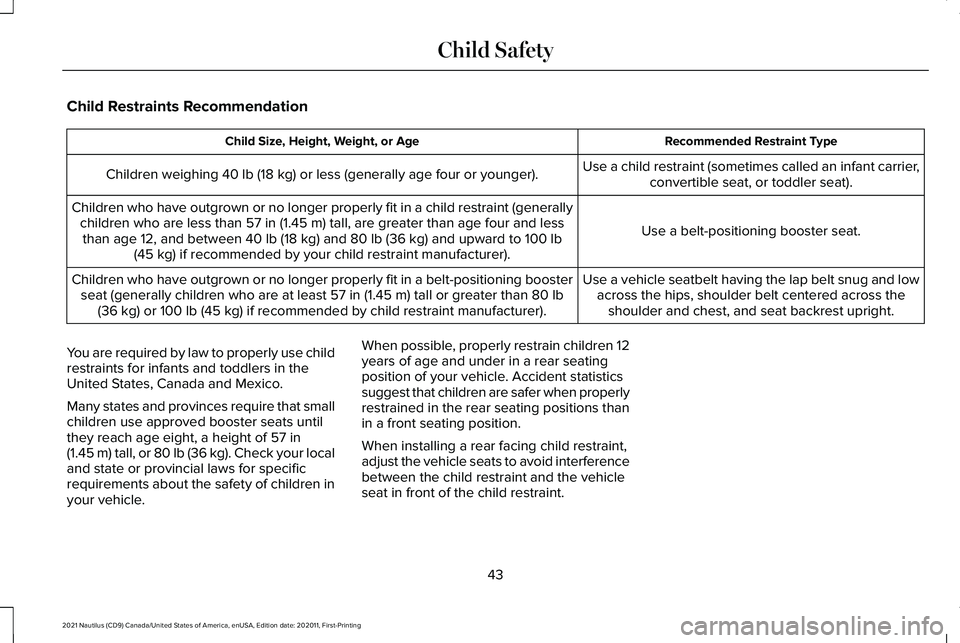
Child Restraints Recommendation
Recommended Restraint Type
Child Size, Height, Weight, or Age
Use a child restraint (sometimes called an infant carrier,convertible seat, or toddler seat).
Children weighing 40 lb (18 kg) or less (generally age four or younger).
Use a belt-positioning booster seat.
Children who have outgrown or no longer properly fit in a child restrain\
t (generally
children who are less than
57 in (1.45 m) tall, are greater than age four and less
than age 12, and between 40 lb (18 kg) and 80 lb (36 kg) and upward to 100 lb
(45 kg) if recommended by your child restraint manufacturer).
Use a vehicle seatbelt having the lap belt snug and lowacross the hips, shoulder belt centered across theshoulder and chest, and seat backrest upright.
Children who have outgrown or no longer properly fit in a belt-positioni\
ng booster
seat (generally children who are at least
57 in (1.45 m) tall or greater than 80 lb
(36 kg) or 100 lb (45 kg) if recommended by child restraint manufacturer).
You are required by law to properly use child
restraints for infants and toddlers in the
United States, Canada and Mexico.
Many states and provinces require that small
children use approved booster seats until
they reach age eight, a height of
57 in
(1.45 m) tall, or 80 lb (36 kg). Check your local
and state or provincial laws for specific
requirements about the safety of children in
your vehicle. When possible, properly restrain children 12
years of age and under in a rear seating
position of your vehicle. Accident statistics
suggest that children are safer when properly
restrained in the rear seating positions than
in a front seating position.
When installing a rear facing child restraint,
adjust the vehicle seats to avoid interference
between the child restraint and the vehicle
seat in front of the child restraint.
43
2021 Nautilus (CD9) Canada/United States of America, enUSA, Edition date: 202011, First-Printing Child Safety
Page 48 of 579
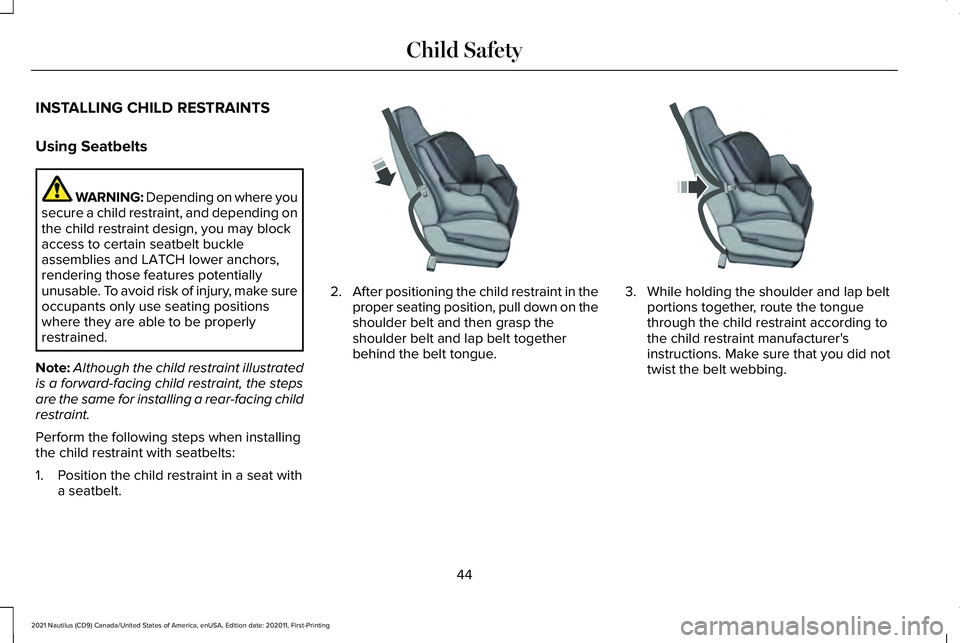
INSTALLING CHILD RESTRAINTS
Using Seatbelts
WARNING: Depending on where you
secure a child restraint, and depending on
the child restraint design, you may block
access to certain seatbelt buckle
assemblies and LATCH lower anchors,
rendering those features potentially
unusable. To avoid risk of injury, make sure
occupants only use seating positions
where they are able to be properly
restrained.
Note: Although the child restraint illustrated
is a forward-facing child restraint, the steps
are the same for installing a rear-facing child
restraint.
Perform the following steps when installing
the child restraint with seatbelts:
1. Position the child restraint in a seat with a seatbelt. 2.
After positioning the child restraint in the
proper seating position, pull down on the
shoulder belt and then grasp the
shoulder belt and lap belt together
behind the belt tongue. 3. While holding the shoulder and lap belt
portions together, route the tongue
through the child restraint according to
the child restraint manufacturer's
instructions. Make sure that you did not
twist the belt webbing.
44
2021 Nautilus (CD9) Canada/United States of America, enUSA, Edition date: 202011, First-Printing Child SafetyE142529 E142530
Page 49 of 579
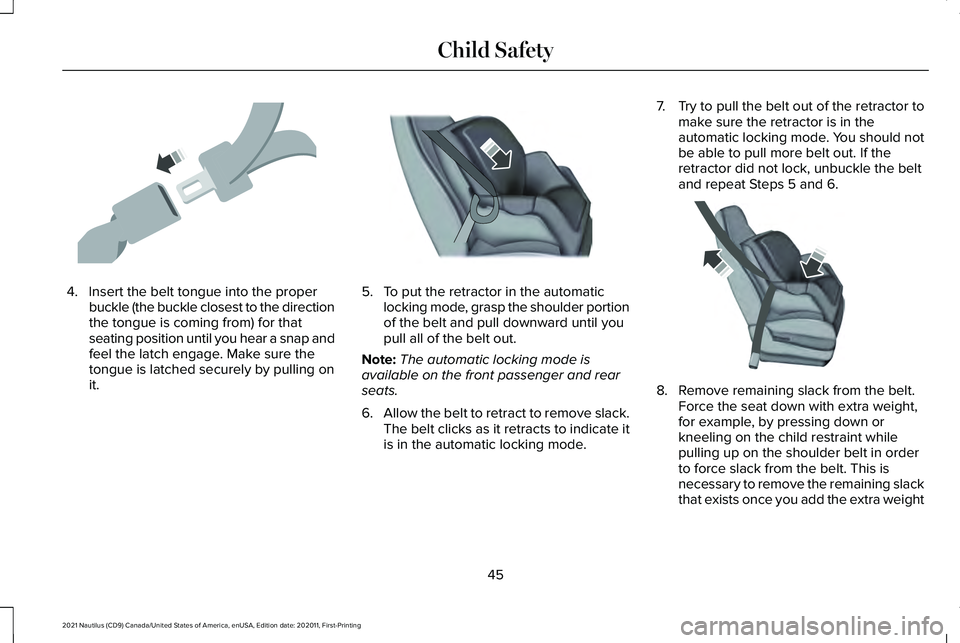
4. Insert the belt tongue into the proper
buckle (the buckle closest to the direction
the tongue is coming from) for that
seating position until you hear a snap and
feel the latch engage. Make sure the
tongue is latched securely by pulling on
it. 5. To put the retractor in the automatic
locking mode, grasp the shoulder portion
of the belt and pull downward until you
pull all of the belt out.
Note: The automatic locking mode is
available on the front passenger and rear
seats.
6. Allow the belt to retract to remove slack.
The belt clicks as it retracts to indicate it
is in the automatic locking mode. 7.
Try to pull the belt out of the retractor to
make sure the retractor is in the
automatic locking mode. You should not
be able to pull more belt out. If the
retractor did not lock, unbuckle the belt
and repeat Steps 5 and 6. 8. Remove remaining slack from the belt.
Force the seat down with extra weight,
for example, by pressing down or
kneeling on the child restraint while
pulling up on the shoulder belt in order
to force slack from the belt. This is
necessary to remove the remaining slack
that exists once you add the extra weight
45
2021 Nautilus (CD9) Canada/United States of America, enUSA, Edition date: 202011, First-Printing Child SafetyE142531 E142875 E142533
Page 50 of 579

of the child to the child restraint. It also
helps to achieve the proper snugness of
the child restraint to your vehicle.
Sometimes, a slight lean toward the
buckle will provide extra help to remove
remaining slack from the belt.
9. If the child restraint has a tether strap, attach it. 10. Before placing the child in the seat,
forcibly move the seat forward and back
to make sure the seat is securely held
in place. To check this, grab the seat at
the belt path and attempt to move it
side to side and forward and back.
There should be no more than 1 in
(2.5 cm) of movement.
We recommend checking with a NHTSA
Certified Child Passenger Safety Technician
to make certain the child restraint is properly
installed. In Canada, check with Transport
Canada for referral to a Child Car Seat Clinic.
Using Lower Anchors and Tethers for
Children WARNING:
Do not attach two child
safety restraints to the same anchor. In a
crash, one anchor may not be strong
enough to hold two child safety restraint
attachments and may break, causing
serious injury or death. WARNING: Depending on where you
secure a child restraint, and depending on
the child restraint design, you may block
access to certain seatbelt buckle
assemblies and LATCH lower anchors,
rendering those features potentially
unusable. To avoid risk of injury, make sure
occupants only use seating positions
where they are able to be properly
restrained.
The LATCH (Lower Anchors and Tethers for
CHildren) system has three vehicle anchor
points.
• Two lower anchors where the seat
backrest and seat cushion meet, called
the seat bight.
• One top tether anchor behind that
seating position.
46
2021 Nautilus (CD9) Canada/United States of America, enUSA, Edition date: 202011, First-Printing Child SafetyE142534